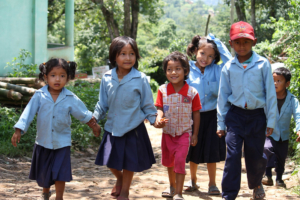Improving Education in Nepal
 In the last few decades, the education system in Nepal has improved thanks to the help from various international organizations. In 2016, the country passed a bill elongating mandatory education from five years to eight years. Additionally, the primary schools’ net enrollment rate reached 97%. However, only half of the students in third, fifth and eighth grade meet the academic standards and the youth literacy rate is 84.8%, compared to the global average of 89.6%, according to the World Education News + Reviews (WENR).
In the last few decades, the education system in Nepal has improved thanks to the help from various international organizations. In 2016, the country passed a bill elongating mandatory education from five years to eight years. Additionally, the primary schools’ net enrollment rate reached 97%. However, only half of the students in third, fifth and eighth grade meet the academic standards and the youth literacy rate is 84.8%, compared to the global average of 89.6%, according to the World Education News + Reviews (WENR).
The Issue
Overall, education in Nepal struggles in a few facets. For one, socioeconomic, ethnic and gender differences exist and often pose challenges in the educational system, according to UNICEF. Secondly, the actual education within primary and secondary schools is quite inconsistent. Also, environmental pressures exist, due to the high earthquake risk, and only 11% of schools are earthquake-resistant, UNICEF reports. UNICEF’s partnership with Nepal and its government has made progress, but there is room for improvement.
In 2015, Nepal was hit by two consecutive earthquakes, damaging more than 9,300 schools, and the enrollment rate for schools went down by 6%. At this time, 700,000 people were plunged into poverty, posing a challenge regarding education, WENR reports. Most Nepalis cannot afford private education, but now, even public education is a struggle for low-income households. As a result, a vast gap between socioeconomic groups exists in schools; 65% of the higher-income students were progressing as expected, while of the lower-income students, only 12% were reaching that target, according to UNICEF.
Additionally, access to education is a dire problem. The geographical remoteness within Nepal causes accessibility to schools to be extremely challenging, solely based on proximity. Long distances from schools are the reason for several students dropping out, according to WENR.
The number of female students dropping out is substantially higher than male students. Firstly, child marriage still exists in Nepal, leading to several families marrying off their girls at younger ages. Secondly, female education in Nepal is a pressing issue, as it is not perceived as a priority. According to WENR, in Nepal, there is still a belief that women do not require an education.
Education in Nepal: Solutions
The World Bank’s Program for Results (PforR) aims to help the Nepali government implement more into the education sector. The School Sector Development Program (SSDP) focuses on supporting the Nepali Government’s own SSDP, the PforR and has nine joint-financing partners. After five years of the SSDP, ending in 2022, the rate of students reaching twelfth grade increased by 21.6% for boys and 33.9% for girls, the number of out-of-school children decreased by 6.76%, and in the 15 “most disadvantaged districts,” enrollment increased by more than 7%, according to the World Bank.
Overall, nearly 8.1 million students, nationally, benefitted from the SSDP. With the support of the World Bank, the SSDP created targeted scholarships, which allowed girls and disadvantaged children to continue their educational careers, the World Bank reports.
Additionally, UNICEF partnered with the SSDP as another JFP to improve the quality of early childhood education (ECE). Right now, enrollment for ECEs is only 51%, so UNICEF is also working towards increasing accessibility. Another goal is to support students entering school later in their careers, as well as those choosing alternative educational paths, including informal classes, etc. Along with that, strengthening the overall safety plan of schools (Comprehensive School Safety Master Plans), and checking in on out-of-school students (often those with disabilities) are on its list as well, UNICEF reports.
Overall, with help from UNICEF and the World Bank, education in Nepal is slowly improving. However, there is still scope for improvement. At this point, 770,000 children do not attend school, according to UNICEF. Working towards getting more children in school and jumpstarting their careers is the next step to improving Nepal’s education as a whole.
– Lakshya Anand
Lakshya is based in Bellevue, WA, USA and focuses on Good News for The Borgen Project.
Photo: Flickr
